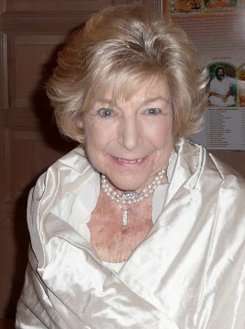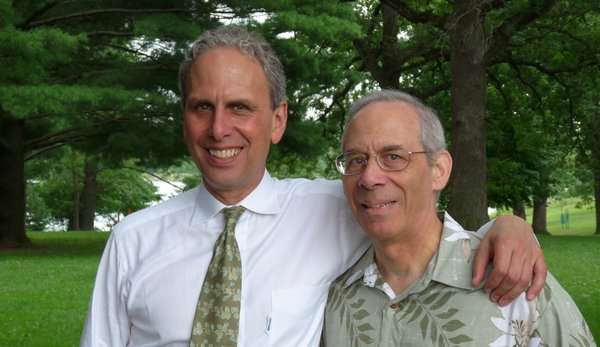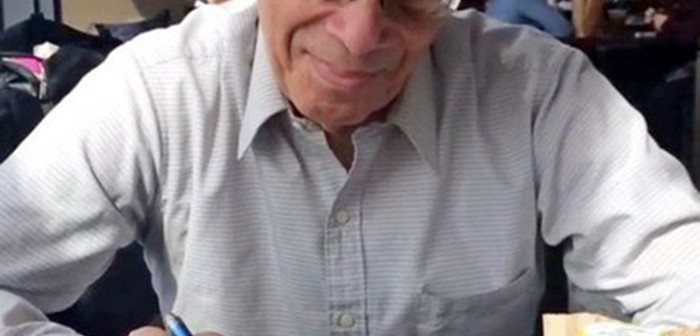In 1967, Ken Chawkin walked into the local TM centre without any intention of learning Transcendental Meditation. He simply wanted to buy a copy of The Science of Being and Art of Living written by Maharishi Mahesh Yogi.
 From a no-no to a go-go
From a no-no to a go-go
“I was kind of lost and seeking. I did not think I needed Transcendental Meditation – I thought I would understand everything by reading books!” Ken chuckles.
Yet that day he did end up learning TM and it set the course for his whole life.
“A lot of things fell into place,” he sums it up. After the course, the teacher asked if Ken was willing to set up talks on TM for his fellow students at Loyola College, now Concordia University. “So I set up a lecture and, automatically, I started doing PR for Transcendental Meditation – talking about it, putting up posters, doing radio talk shows and writing articles.“
Not that he just talked; Ken walked the talk too. “Studying at university, I was experiencing all the benefits I was talking about!” he recalls.
Long story short, Ken became a TM teacher, taught at the most successful TM centre in North America, and later worked on PR for the TM organization in USA, Maharishi University of Management and the David Lynch Foundation.
Ken’s inquisitiveness and natural affinity with people is responsible for the fact that stories about Transcendental Meditation have been featured in such media giants as The Washington Post, The New York Times, The Los Angeles Times, International Herald Tribune, Better Homes and Gardens, Jane Magazine, History Channel, El Mercurio, The Telegraph, Daily Mirror, The Times, ANI, The Times of India,BBC, AFP, VOA, ANSA – and numerous other newspapers, TV channels and news agencies across the globe.
“It’s just in my dharma – I make friends with people. Genuinely, cause I like them and I am interested in them and in what they do,” is Ken’s modest explanation of his success. He happily gives all the credit to researchers, TM teachers and others connected with the published studies. “Our job is just the icing on the cake and delivery to the wider public.“
Planting the seeds of change
However, insiders know that Ken’s contribution to the TM movement is not limited to his amazing PR feats. He has planted other seeds that have sprouted into mighty trees.
Recalling the days of his past, Ken happily tells the following story:
“In 1966 I met my grandmother’s cousin in England and we went to visit his friend, Pat Stone. Six years later I again met up with both my cousin and Pat. She noticed a big change in me and was curious – what had I been doing?
“I said I just came from a six-month TM teacher training course with Maharishi Mahesh Yogi. She asked me to talk about it and so right then and there I gave my very first introductory lecture as a teacher. She was very interested and wanted me to instruct her.”

Pat Stone
Since Ken could not legally work in the UK without a work Visa, he looked up the local TM center for her. The effects of TM on Pat turned out to be transformative in every sense of the word.
“She was an antique dealer and in her store she used to be known as Dizzy Lizzy. One day this lady comes to her and asks her: “Have you seen Dizzy Lizzy?“ She could not recognize Pat! She had stopped eating heavy foods and lost weight. Her heart murmur had cleared up and she was calm and focused!
“I often brag she was the best student I never taught! Later I received this beautiful 11-page letter from her thanking me for introducing her to TM. She said, “You know, Ken, even if you don’t end up teaching TM to a lot of people, just know that you have planted a seed here and one day it will grow into a might oak tree and thousands of seeds will come from that!”
Indeed. Pat Stone ended up becoming a teacher herself and has by now taught TM to over 25,000 people in the UK!
“She loves to teach! She is a true legend and we are so proud of her.“

Ken Chawkin with his friend Bob Roth, TM teacher and the Executive Director of the David Lynch Foundation
Sometimes poetry just happens
Today, Ken’s blog features both news and stories about TM, and his poetry. Like TM, writing poems came into Ken’s life without knocking.
In 2000-2001, a project took him on a journey to Indonesia.
“When I got there I just meditated and slept for a couple of days to get over the jetlag. One morning I was dreaming and in the dream these words came to me:
He hides within the rock of three dimensions and cannot be found in this world.
“’Wow, where did that come from?!’ I wondered. So I woke myself up and wrote it down and the whole thing just unfolded itself. It was very mysterious – and then I found out what it meant.”
When Ken shared the poem with people familiar with Javanese culture, they immediately knew who he had been talking about – Nyi Roro Kidul, the mythic queen of the Southern Seas.

Ken Chawkin, writing a haiku in New York
Years earlier back in Fairfield, Ken started to look into writing as a process of self-discovery.
“I joined a group of writers but I myself never wrote, only listened to what others had written. I was inspired by the creative process and what it could do to us.
“One time I was driving around with a friend outside Fairfield and discovered this park off a beaten track. There were two ponds with lotus pads in them. My friend was an artist and she started sketching. I asked her for a piece of paper and started writing about the scene.
“We stopped for a moment and talked about how powerful this experience was, looking at the lotus pads. We talked about how everything has consciousness – the plants included. And that our attention influences what we see.
“I started writing again wondering what it would be for me to look at myself from the perspective of these lotuses. We observe objects, yet embedded within the object is consciousness – looking at us, experiencing us. So there has got be a flow in between, the mutual process of knowing and recognition. It’s not restricted to one side of the equation.
“So I let go. All of a sudden, my mind was in a heightened state and I began writing from the perspective of the lotus pads and this whole poem came out in one take and I thought: ‘Oh my god, that’s a poem!’”
Black lines briefly sketched on paper
capture our appearance but not our essence.
Your attention interests us,
although others have never before.
Your watchful eyes tell us
we areapart of you.
Can you feel our thoughts?
Can you think our feelings?
We do yours
and we thank you for committing us to memory.
For long after we’ve gone
and transmuted ourselves back into nature
our likeness will remind you that we were.
And your response will touch our hearts.
Ken submitted the poem to a competition and “ODE TO THE ARTIST, Sketching Lotus Pads at Round Prairie Park” won the Sparrowgrass Poetry Forum’s Distinguished Poet Award (1988). Later it was published in the winter edition of Treasured Poems of America.
“The editor wanted me to submit another poem and I got really nervous about it. I knew I did not write that poem – it had been dictated to me!” Ken says, laughing.
“Finally, I decided to write about the memory of the process behind the initial poem. As soon as I sat down with that idea, bliss started to flow. And then I wrote the poem called “Sometimes Poetry Happens.”
“At first I had difficulty with the last section because I was trying too hard. Then I gave up and it just wrote itself! A lot of poems present themselves with an ending you never could have imagined.”
Some poets can write
from reflected experience
referring back to what was written.
Others need to be there,
in full view of their subject,
opening up to what’s being given.
Sometimes poetry happens between the two.
It’s then you don’t really write the poem.
It writes you!
You just put it down on paper.
When you see it there,
you’ve captured it.
Or, rather, it’s captured you.
What really happened between the two?
To explore that space
between you and me
is to discover who we are.
For deep within,
at the source of the gap
lie the togetherness of the three—
the seer, the seen, and the poetry … in between.
 How do these beautiful lines come to be?
How do these beautiful lines come to be?
“My feeling is we are midwives and a poem wants to get expressed, wants to be born,” explains Ken.
“That’s why artists are humble because they have been given this opportunity to be a midwife. It’s a collaborative process. If the ego and intellect get too involved, the magic is not going to happen.”
In Ken’s life, there has been a lot of letting go – and a lot of magic happening as a result.
To see more poetry, interesting TM articles and interviews, visit Ken’s wonderful and inspiring blog at http://theuncarvedblog.com.
This article originally appeared on TM Home at: www.tmhome.com
Sign up for the next talk nearest you on our site at: http://switzerland.tm.org/web/m/find-a-teacher

 Deutsch
Deutsch English
English  Français
Français 


